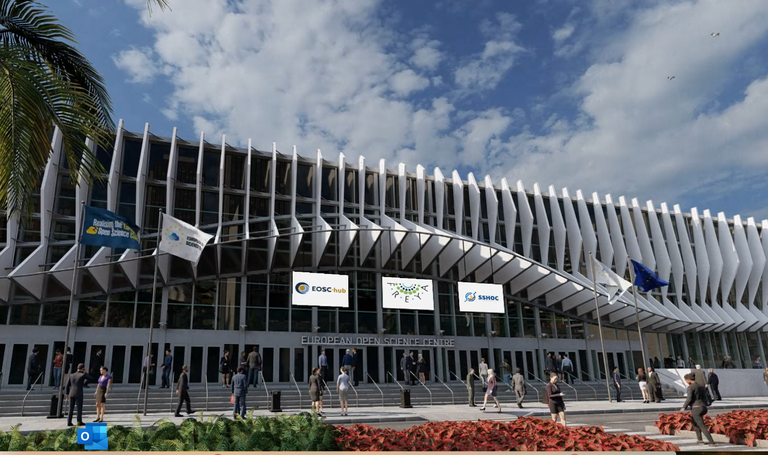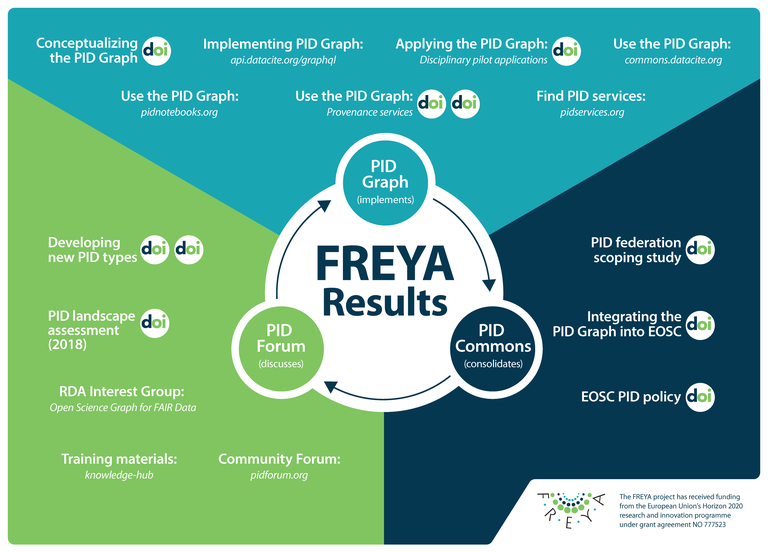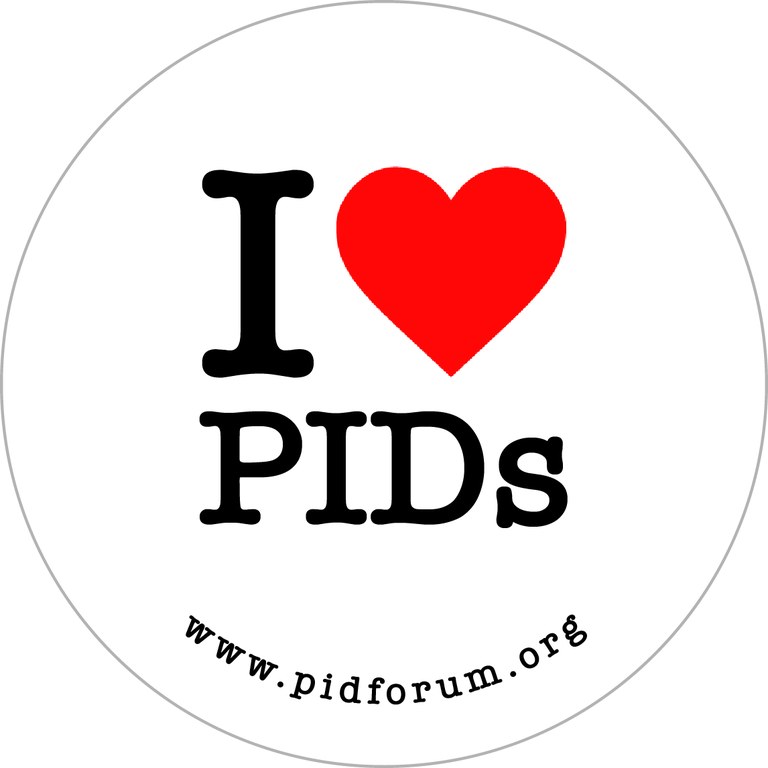Presenting FREYA Results: Realising the EOSC
The FREYA project is coming to an end in november 2020 and this is the time to present an overview of the project’s results and achievements.
Together with our sister-projects EOSC-Hub and SSHOC, FREYA organized a conference in the week of the 16th november 2020 which we used to showcase the project’s results and discuss their uptake and sustainability. The conference was titled Realising the European Open Science Cloud: Towards a FAIR Research Data Landscape for the social sciences humanities and beyond and was structured along four main themes: policy & governance,technology & infrastructure, training & community building, and sustainability & the future. Across the four days, the conference attracted 690 registrants from 45 different countries who joined us in the various sessions to discuss and exchange.
This blog post provides an overview of the conference highlights from a PID perspective. We discuss the major achievements FREYA has made over the past three years that we presented during the online #RealisingEOSC event.

Screenshot from the online conference Realising the EOSC which FREYA co-organized together with EOSC-Hub and SSHOC in november 2020.
Achievements of the project
The aim of the FREYA project was to extend the infrastructure for persistent identifiers (PIDs) as a core component of open research, to improve discovery, navigation, retrieval, and access to research resources.
The project was structured along three main pillars: The PID Graph, The PID Forum and the PID Commons.
-
The PID Graph connects and integrates PID systems, creating relationships across a network of PIDs and serving as a basis for new services
-
The PID Forum provides a platform for engagement with the global community and promotes uptake of our outcomes and services.
-
The PID Commons addresses the sustainability of the PID infrastructure resulting from FREYA beyond the lifetime of the project
An overview of key results for each of these pillars is given in the Figure below. A pdf version of the infographic is available here and includes links to the DOIs and webpages.

Infographic presenting an overview of key results of the FREYA project.
The PID Graph
FREYA has worked on the conceptualization of the PID Graph (read more in this deliverable) and has released several PID Graph Services. The PID Graph Services session (recording) at our Realising the EOSC event presented an overview of these services including:
-
the GraphQL API (read more in this blog post)
-
the Jupyter notebooks (read more on pidnotebooks.org)
-
the DataCite Commons Common DOI Search (read more in this blog post).
FREYA has established a registry of PID services which is available at pidservices.org (read more about the registry in this blog post).
FREYA also conducted work on new PID types and has established a variety of disciplinary demonstrators which were discussed in a separate session on Developing the PID Graph - Implementations by the FREYA project and beyond (recording). The new PID types and disciplinary applications that were developed as part of the FREYA project are described in more detail in our project deliverables of Work Package 3 and 4. More information is available on our website on
The PID Forum
The PID Forum was FREYA’s way of engagement with the broader PID Community. This included iterative engagement with various stakeholders to develop use cases (described in Deliverable 3.2) and an assessment of the PID landscape (described in Deliverable 3.1).
Moreover, we established pidforum.org as an online space for exchange. The online PID Forum was discussed in the PID Forum session (recording) where we presented the ideas behind the forum as well as its future plans. NISO has been selected to take over the hosting of the Forum after the end of FREYA (see this news item) to ensure that its 500+ members can continue to use pidforum.org as a place for exchange and collaboration.
Next to our engagement with the community FREYA has also actively invested in PID training activities. We established a Knowledge Hub (read more about it here) which contains developed training materials including, for instance, Guides for chosing PIDs (available here). Our training materials and achievements were presented in a dedicated session entitled FREYA Knowledge Hub and Training (recording) at our Realising the EOSC event.
To reach a wider community, FREYA has established an ambassador network with 37 ambassadors from 21 different countries. In a session on Community Building Examples Across EOSC-hub, FREYA, & SSHOC (recording), FREYA presented this network and our activities and we discussed successes and challenges in building communities with our fellow EOSC projects.
The PID Commons
The third pillar of FREYA was concerned with governance and sustainability of the PID infrastructure FREYA has been developing.
During a dedicated session The FREYA PID Commons and the PID federation (recording) during our Realising the EOSC event, we presented the major achievements of the PID Commons Pillar including the assessment of the PID federation FREYA initiated (read more in this blog post).
FREYA has worked in collaboration with the EOSC to build the PID infrastructure that is closely connected to the EOSC and its projects. The session on The Places of PIDs in EOSC (recordings) discussed various aspects and use cases of PIDs in EOSC across a variety of disciplines. The EOSC PID policy that FREYA partners have contributed to was also part of this session (read more about the policy this thread on the PID Forum).
Sustainability also formed the topic of the last day of our Realising the EOSC conference. In a plenary session Sustainability of FAIR Research Data and Services for the SSH and Beyond (recording) FREYA, EOSC-Hub and SSHOC presented their key exploitable results and discussed major issues around sustainability in the EOSC together with an panel of experts.
Want to know more about the Realising the EOSC event?
An overview of all the sessions that were held at the Realising the EOSC event is available on the EOSC-Hub website. An overview of the FREYA sessions including related recording and slides is available on the FREYA website.
Presentations given at the conference are made available through this dedicated Zenodo community page and recordings of the sessions are available on this dedicated YouTube playlist.
Want to know more about FREYA’s results?
If you would like to know more about the FREYA project and its results, there is a lot of information and resources on our website.
The PID Services are described in a dedicated tab of the website.
An overview of the project outputs is available under resources. These include
-
Public deliverables
-
Publications
-
Computational notebooks
-
A list of FREYA webinars.
Key events are listed on a dedicated page including links to recordings and other materials.
We have written more than 70 blog posts over the course of the project which will remain available on the FREYA blog.
The FREYA project has its own YouTube channel where recordings of our webinars as well as demos and videos can be watched.
To ensure that materials related to the project remain finable and accessible, we established a dedicated Zenodo Community page for the FREYA project.
FREYA's results will live on
Although the FREYA project is ending, the project partners will remain an active part of the PID community and carry on the results and spirit of the project. Many of our results will be sustained by the involved FREYA partners, including the DataCite Commons and the GraphQL implementation. The established RDA Interest Group Open Science Graphs for FAIR Data and the PID Interest Group will continue their work. And of course all PID-lovers remain welcome at the pidforum.org which will continue to be the online place for the wider PID community!
